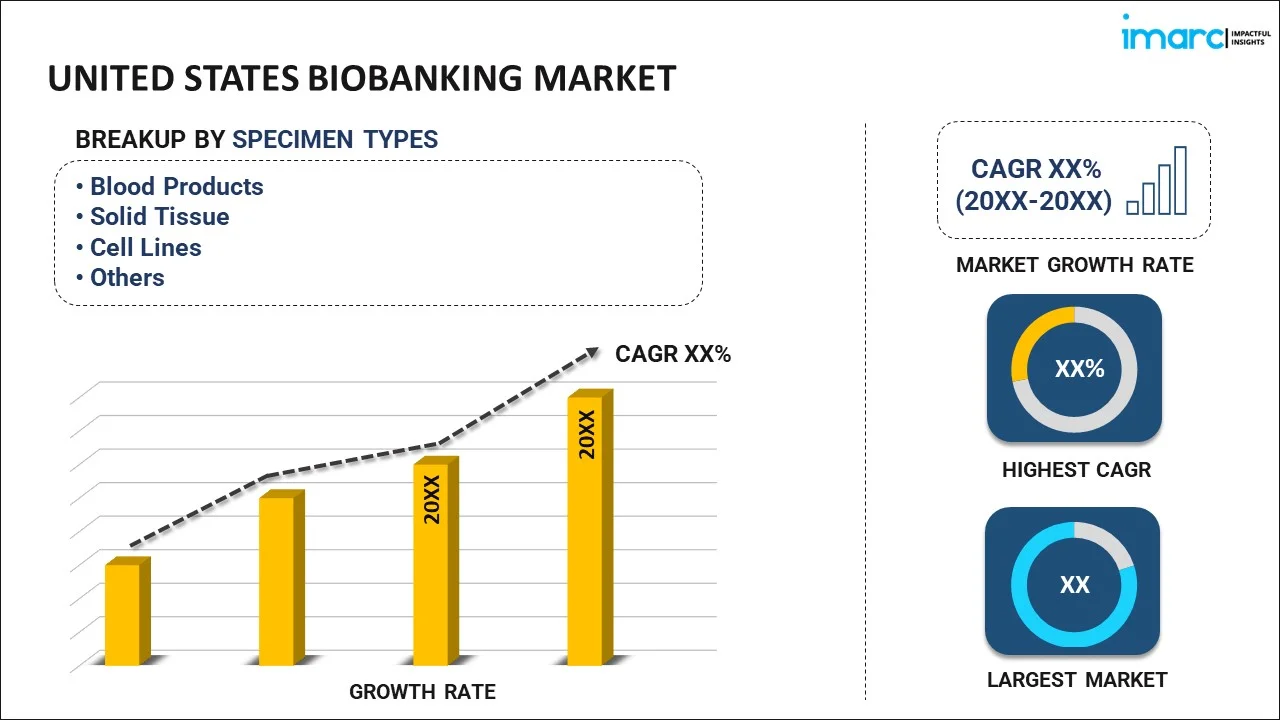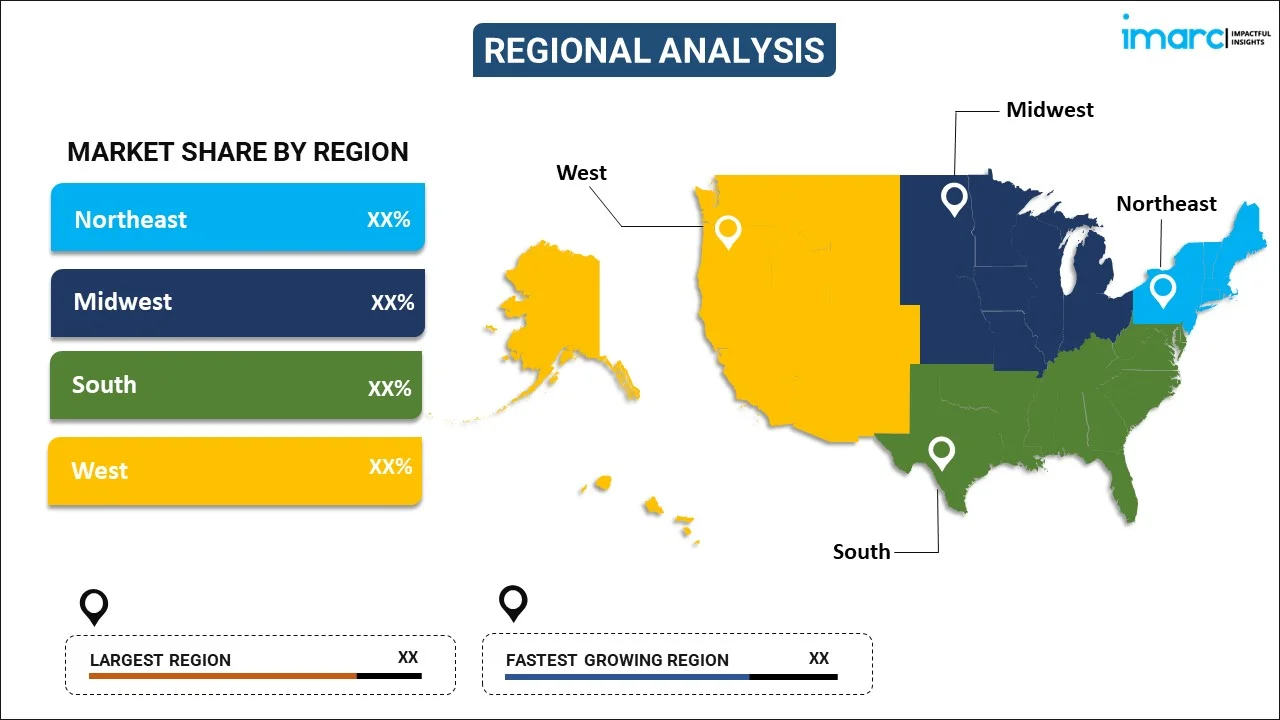
United States Biobanking Market Report by Specimen Type (Blood Products, Solid Tissue, Cell Lines, Nucleic Acid, and Others), Biobank Type (Population-based Biobanks, Disease-oriented Biobanks), Application (Therapeutics, Research), End User (Academic Institutions, Pharma and Biotech Companies), and Region 2025-2033
Market Overview:
United States biobanking market size is projected to exhibit a growth rate (CAGR) of 7.91% during 2025-2033. The growing usage of this process, as it is serving as an invaluable resource in advancing medical knowledge, and improving healthcare outcomes are primarily driving the market growth.
|
Report Attribute
|
Key Statistics
|
|---|---|
|
Base Year
|
2024 |
|
Forecast Years
|
2025-2033
|
|
Historical Years
|
2019-2024
|
| Market Growth Rate (2025-2033) | 7.91% |
Biobanking involves the systematic collection, storage, annotation, and distribution of bodily fluid or tissue samples for research purposes, aiming to advance our understanding of health and diseases. Functioning as a reliable repository, it provides access to a reservoir of high-quality samples and their associated data. It plays a crucial role in the diagnosis and development of medicines for various disorders, serving as a foundation for enhancing personalized medical approaches where the identification of effective biomarkers is essential for disease diagnosis and prognosis. Acting as an intermediary between donors and researchers, biobanking facilitates numerous research endeavors and diverse studies. With stringent quality control measures, it contributes to improving the reproducibility of experiments. Additionally, the data generated from bio samples becomes instrumental in the digital transformation of health systems. Consequently, biobanking finds extensive applications in drug and biomarker development, clinical therapy, and the monitoring of clinical trials to assess the impact of drugs on eventual outcomes.
United States Biobanking Market Trends:
The United States biobanking market is experiencing significant growth, driven by the increasing importance of research in understanding and combating various health conditions. The market provides a vital resource, offering researchers access to high-quality samples and associated data, thereby playing a crucial role in diagnostics, drug development, and personalized medicine. Additionally, with a focus on effective biomarker identification for disease diagnosis and prognosis, biobanking serves as a bridge between donors and researchers, facilitating a wide range of studies. Besides this, the stringent quality control measures employed in biobanking contribute to enhancing the reproducibility of experiments, a critical aspect in scientific research. Moreover, the data generated through bio samples holds significant value for the ongoing digital transformation of health systems. Apart from this, as the demand for precision medicine and targeted therapies grows, the United States biobanking market is poised for sustained expansion over the forecasted period.
United States Biobanking Market Segmentation:
IMARC Group provides an analysis of the key trends in each segment of the market, along with forecasts at the country level for 2025-2033. Our report has categorized the market based on specimen type, biobank type, application, and end user.
Specimen Type Insights:

- Blood Products
- Solid Tissue
- Cell Lines
- Nucleic Acid
- Others
The report has provided a detailed breakup and analysis of the market based on the specimen type. This includes blood products, solid tissue, cell lines, nucleic acid, and others.
Biobank Type Insights:
- Population-based Biobanks
- Disease-oriented Biobanks
A detailed breakup and analysis of the market based on biobank type have also been provided in the report. This includes population-based biobanks and disease-oriented biobanks.
Application Insights:
- Therapeutics
- Research
The report has provided a detailed breakup and analysis of the market based on the application. This includes therapeutics and research.
End User Insights:
- Academic Institutions
- Pharma and Biotech Companies
A detailed breakup and analysis of the market based on end user have also been provided in the report. This includes academic institutions and pharma and biotech companies.
Regional Insights:

- Northeast
- Midwest
- South
- West
The report has also provided a comprehensive analysis of all the major regional markets, which include the Northeast, Midwest, South, and West.
Competitive Landscape:
The market research report has also provided a comprehensive analysis of the competitive landscape in the market. Competitive analysis such as market structure, key player positioning, top winning strategies, competitive dashboard, and company evaluation quadrant has been covered in the report. Also, detailed profiles of all major companies have been provided.
United States Biobanking Market Report Coverage:
| Report Features | Details |
|---|---|
| Base Year of the Analysis | 2024 |
| Historical Period | 2019-2024 |
| Forecast Period | 2025-2033 |
| Units | Million USD |
| Scope of the Report | Exploration of Historical and Forecast Trends, Industry Catalysts and Challenges, Segment-Wise Historical and Predictive Market Assessment:
|
| Specimen Types Covered | Blood Products, Solid Tissue, Cell Lines, Nucleic Acid, Others |
| Biobank Types Covered | Population-based Biobanks, Disease-oriented Biobanks |
| Applications Covered | Therapeutics, Research |
| End Users Covered | Academic Institutions, Pharma and Biotech Companies |
| Regions Covered | Northeast, Midwest, South, West |
| Customization Scope | 10% Free Customization |
| Post-Sale Analyst Support | 10-12 Weeks |
| Delivery Format | PDF and Excel through Email (We can also provide the editable version of the report in PPT/Word format on special request) |
Key Questions Answered in This Report:
- How has the United States biobanking market performed so far and how will it perform in the coming years?
- What has been the impact of COVID-19 on the United States biobanking market?
- What is the breakup of the United States biobanking market on the basis of specimen type?
- What is the breakup of the United States biobanking market on the basis of biobank type?
- What is the breakup of the United States biobanking market on the basis of application?
- What is the breakup of the United States biobanking market on the basis of end user?
- What are the various stages in the value chain of the United States biobanking market?
- What are the key driving factors and challenges in the United States biobanking?
- What is the structure of the United States biobanking market and who are the key players?
- What is the degree of competition in the United States biobanking market?
Key Benefits for Stakeholders:
- IMARC’s industry report offers a comprehensive quantitative analysis of various market segments, historical and current market trends, market forecasts, and dynamics of the United States biobanking market from 2019-2033.
- The research report provides the latest information on the market drivers, challenges, and opportunities in the United States biobanking market.
- Porter's five forces analysis assist stakeholders in assessing the impact of new entrants, competitive rivalry, supplier power, buyer power, and the threat of substitution. It helps stakeholders to analyze the level of competition within the United States biobanking industry and its attractiveness.
- Competitive landscape allows stakeholders to understand their competitive environment and provides an insight into the current positions of key players in the market.
Need more help?
- Speak to our experienced analysts for insights on the current market scenarios.
- Include additional segments and countries to customize the report as per your requirement.
- Gain an unparalleled competitive advantage in your domain by understanding how to utilize the report and positively impacting your operations and revenue.
- For further assistance, please connect with our analysts.
 Inquire Before Buying
Inquire Before Buying
 Speak to an Analyst
Speak to an Analyst
 Request Brochure
Request Brochure
 Request Customization
Request Customization




.webp)




.webp)












